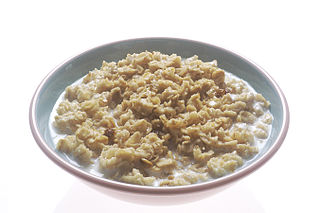
Porridge is a food made by heating or boiling ground, crushed or chopped starchy plants, typically grain, in milk or water. It is often cooked or served with added flavourings such as sugar, honey, fruit, or syrup to make a sweet cereal, or it can be mixed with spices, meat, or vegetables to make a savoury dish. It is usually served hot in a bowl, depending on its consistency. Oat porridge, or oatmeal, is one of the most common types of porridge. Gruel is a thinner version of porridge and congee is a savoury variation of porridge of Asian origin.

Buckwheat or common buckwheat is a flowering plant in the knotweed family Polygonaceae cultivated for its grain-like seeds and as a cover crop. Buckwheat originated around the 6th millennium BCE in the region of what is now Yunnan Province in southwestern China. The name "buckwheat" is used for several other species, such as Fagopyrum tataricum, a domesticated food plant raised in Asia.
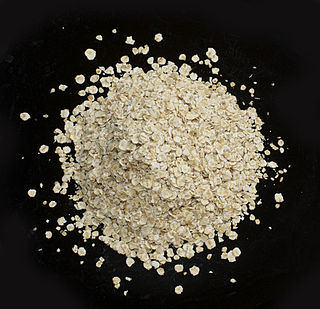
Oatmeal is a preparation of oats that have been de-husked, steamed, and flattened, or a coarse flour of hulled oat grains (groats) that have either been milled (ground), rolled, or steel-cut. Ground oats are also called white oats. Steel-cut oats are known as coarse oatmeal, Irish oatmeal, or pinhead oats. Rolled oats were traditionally thick old-fashioned oats, but can be made thinner or smaller, and may be categorized as quick oatmeal or instant oatmeal depending on the cooking time required, which is determined by the size of the oats and the amount of precooking.

Borscht is a sour soup, made with meat stock, vegetables and seasonings, common in Eastern Europe and Northern Asia. In English, the word borscht is most often associated with the soup's variant of Ukrainian origin, made with red beetroots as one of the main ingredients, which give the dish its distinctive red color. The same name, however, is also used for a wide selection of sour-tasting soups without beetroots, such as sorrel-based green borscht, rye-based white borscht, and cabbage borscht.
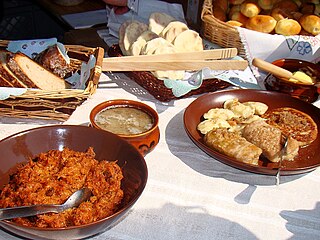
Polish cuisine is a style of food preparation originating in and widely popular in Poland. Due to Poland's history, Polish cuisine has evolved over the centuries to be very eclectic, and shares many similarities with other national cuisines. Polish cooking in other cultures is often referred to as à la polonaise.

Russian cuisine is a collection of the different dishes and cooking traditions of the Russian people as well as a list of culinary products popular in Russia, with most names being known since pre-Soviet times, coming from all kinds of social circles.

Shchi is a Russian-style cabbage soup. When sauerkraut is used instead, the soup is called sour shchi, while soups based on sorrel, spinach, nettle, and similar plants are called green shchi. In the past, the term sour shchi was also used to refer to a drink, a variation of kvass, which was unrelated to the soup.

Eastern European cuisine encompasses many different cultures, ethnicities, languages, and histories of Eastern Europe.
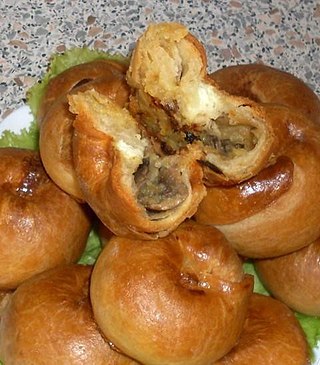
A knish or is a traditional Ashkenazi Jewish snack food consisting of a filling covered with dough that is typically baked or sometimes deep fried.

Groats are the hulled kernels of various cereal grains, such as oats, wheat, rye, and barley. Groats are whole grains that include the cereal germ and fiber-rich bran portion of the grain, as well as the endosperm.

A whole grain is a grain of any cereal and pseudocereal that contains the endosperm, germ, and bran, in contrast to refined grains, which retain only the endosperm.

Belarusian cuisine refers to the culinary traditions native to Belarus. It shares many similarities with cuisines of other Eastern, Central and Northeastern European countries, based predominantly on meat and various vegetables typical for the region.
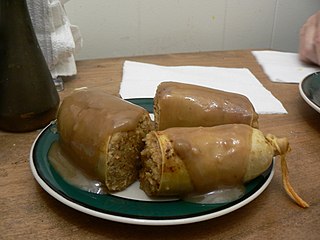
Kishka or kishke refers to various types of sausage or stuffed intestine with a filling made from a combination of meat and meal, often grain or potato. The dish is popular across Eastern Europe as well as with immigrant communities from those areas. It is also eaten by Ashkenazi Jews who prepare their version according to kashrut dietary laws.

Pirog is a baked case of dough with either sweet or savory filling. The dish is common in Eastern European cuisines.

Kashe varnishkes is a traditional dish of the American-Jewish Ashkenazi community. It combines kasha with noodles, typically bow-tie shape lokshen egg noodles.
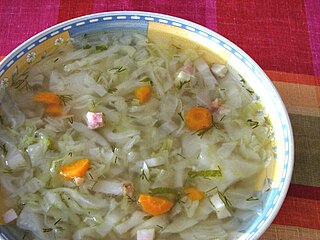
Cabbage soup may refer to any of the variety of soups based on various cabbages, or on sauerkraut and known under different names in national cuisines. Often it is a vegetable soup, with lentils, peas or beans in place of the meat. It may be prepared with different ingredients. Vegetarian cabbage soup may use mushroom stock. Another variety is using a fish stock. There's also a preference to cook cabbage soup using a pork stock.

Bulgur, or burghul, is a cracked wheat foodstuff found in South Asian cuisine and West Asian cuisine.


















